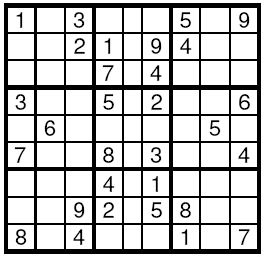Sudoku
| Time Limit: 2000MS | Memory Limit: 65536K | |||
| Total Submissions: 9679 | Accepted: 4791 | Special Judge | ||
Description
Sudoku is a very simple task. A square table with 9 rows and 9 columns is divided to 9 smaller squares 3x3 as shown on the Figure. In some of the cells are written decimal digits from 1 to 9. The other cells are empty. The goal is to fill the empty cells with decimal digits from 1 to 9, one digit per cell, in such way that in each row, in each column and in each marked 3x3 subsquare, all the digits from 1 to 9 to appear. Write a program to solve a given Sudoku-task.


Input
The input data will start with the number of the test cases. For each test case, 9 lines follow, corresponding to the rows of the table. On each line a string of exactly 9 decimal digits is given, corresponding to the cells in this line. If a cell is empty it is represented by 0.
Output
For each test case your program should print the solution in the same format as the input data. The empty cells have to be filled according to the rules. If solutions is not unique, then the program may print any one of them.
Sample Input
1 103000509 002109400 000704000 300502006 060000050 700803004 000401000 009205800 804000107
Sample Output
143628579 572139468 986754231 391542786 468917352 725863914 237481695 619275843 854396127
思路:
要填的数字有 1~9 ,判断是否可以填的条件有,两个,1, 3*3的矩阵内是否会重复,2,纵向和横向是否会重复,只需要把每一个3*3的矩阵内的数字用一个数组标记下,即非零的部分标记为 1 ,否则为0,纵横向直接遍历判断即可;
#include<iostream>
#include<string>
#include<map>
#include<cstdlib>
#include<cstring>
#include<cstdio>
using namespace std;
int book[10][10],mp[10][10],flag;
int check(int x_,int y_,int n);
void dfs(int x,int y) {
if(x == 8 && y == 8) {
flag = 1;
return;
}
int p_x = -1,p_y = -1;
//找出为空的 坐标然后退出下面这个双重循环
for(int i = x ; i < 9 ; ++i) {
for(int j = 0 ; j < 9 ; ++j) {
if(!mp[i][j]) {
p_x = i;p_y = j;
break;
}
}
if(p_x != -1 && p_y != -1) break;
}
// 如果上面的循环都没能找到一个为空的坐标,说明已经把空填满了;
if(p_x == -1 && p_y == -1) {flag = 1; return;}
for(int k = 1 ; k <= 9 ; ++k) {
if(!book[(p_x/3)*3+p_y/3+1][k] && check(p_x,p_y,k)) {
mp[p_x][p_y] = k; // 更新坐标
book[(p_x/3)*3+p_y/3+1][k] = 1; //3*3矩阵的标记
dfs(p_x,p_y);
if(flag == 1) return;
book[(p_x/3)*3+p_y/3+1][k] = 0;
mp[p_x][p_y] = 0; // 还原坐标
}
}
}
// 检查 横向和纵向是否存在相同的数字,是这返回0否则1;
int check(int x_,int y_,int n) {
for(int i = 0 ; i < 9 ; ++i) if(mp[i][y_] == n) return 0;
for(int i = 0 ; i < 9 ; ++i) if(mp[x_][i] == n) return 0;
return 1;
}
int main(void)
{
int n;
cin >> n;
while(n--) {
memset(book,0,sizeof(book));
for(int i = 0 ; i < 9 ; ++i) {
for(int j = 0 ; j < 9 ; ++j) {
scanf("%1d",&mp[i][j]);
// (i/3)*3 + j/3 + 1 是判定 3*3矩阵的区域,
// 每层三个 3*3的区域块,从左至右开始编号 123/456/789,一个矩阵内的非0数
// 用book来标记,非0则标记为 1 否则为0;
if(mp[i][j]) book[(i/3)*3+j/3+1][mp[i][j]] = 1;
}
}
flag = 0;
dfs(0,0);
for(int i = 0 ; i < 9 ; ++i) {
for(int j = 0 ; j < 9 ; ++j)
cout << mp[i][j];
cout << endl;
}
}
return 0;
}